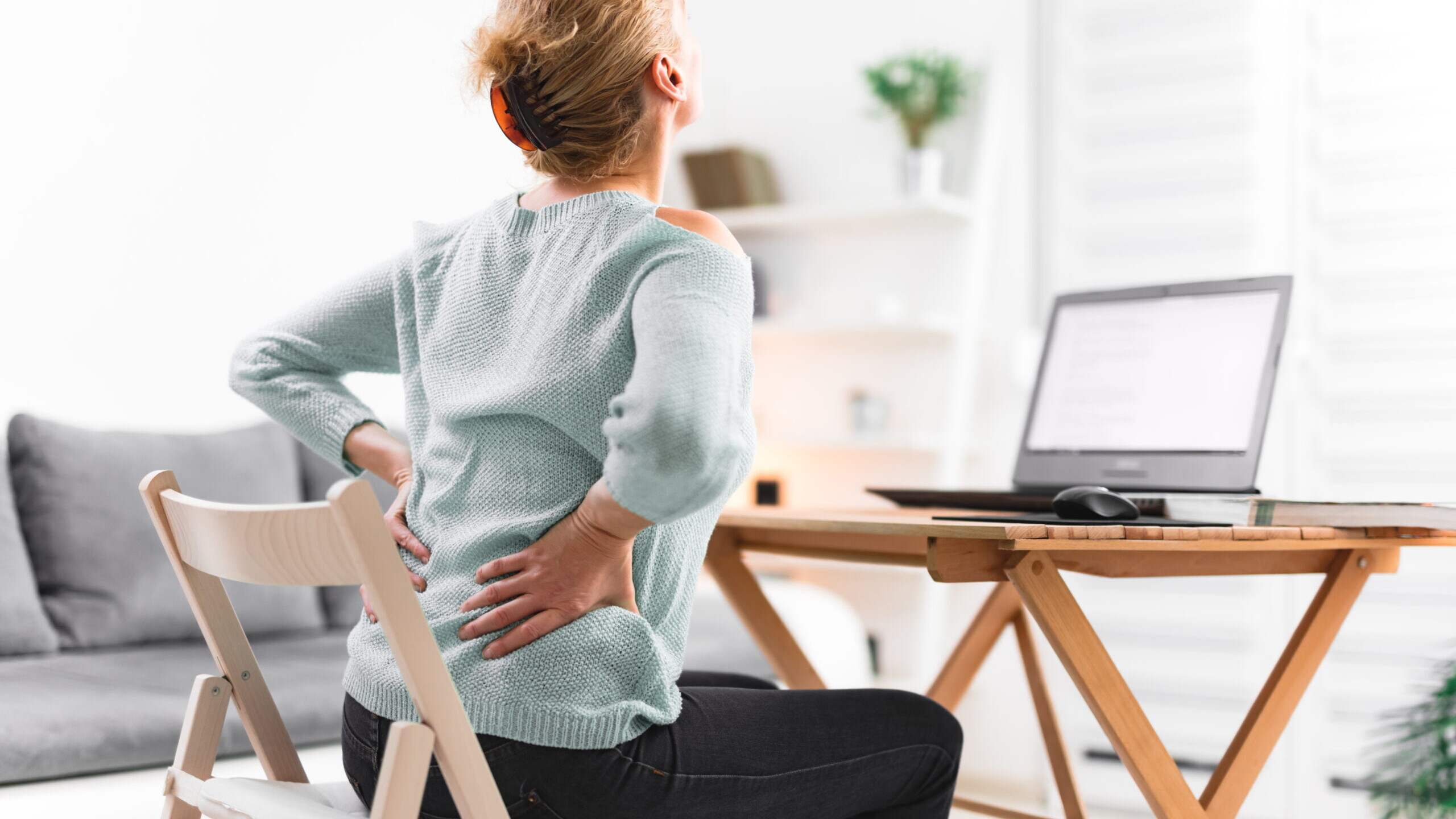
How good is it to be out of Lockdown 6 and back to some of the sort of activities that we simply used to take for granted! Gyms are open, our hair can get cut (thank God), we can go for a swim, and no longer do we need to fiddle with the computer screen to ensure we can see our remote group class teacher via Zoom! And whilst so much is changing for the better, one thing that is lagging is the flow of people back into their old office spaces. There are so many advantages to working from home: saving on travel time is the obvious one, reduced COVID risk, working in your PJ’s (well, maybe from the bottom down), more productivity with less distractions, reduced time and costs with less planes, trains and automobiles; and the list goes on.

But it ain’t all good! In the last 6 months, I have seen more low back and neck pain/headaches in my clients than I have seen in the last 5 years combined. Many of these people have never had spinal issues before the pandemic, yet some of these pain conditions have been severe, a couple ended up at surgery… and literally every one of these pain sufferers comes in and says “But I’ve done nothing”! And therein lies the exact problem.
It’s probably important at this stage to make it clear that the cause of most spinal conditions is multi factorial – it is never as simple as one mistake you have made, one heavy box you shouldn’t have lifted, and certainly not one cough or sneeze that caused your back pain. Many factors interact and contribute to the development of spinal pain, but if ever there has been a time to focus on one factor, I think the time is now. And in what might surprise many this critical factor is not your workplace ergonomics, or the chair you sit on, or the extreme pressure and stress many have found themselves under, or the gym being closed. The critical factor we have been lacking is unstructured and unplanned, but essential, movement. This movement is to and from, but mostly within, our normal office environment, movement that we call Incidental Exercise!
Remember all the positives listed above about your pandemic enforced Work From Home (WFH) lifestyle? This critical lack of Incidental Exercise relates ironically back to exactly these positives – you can roll out of bed in the morning and stumble to the home office in the next room; there’s no walks, no standing on packed trains, no ramps and stairs to negotiate, no-one else to go and chat to in the next office, no stopping in the corridor for idle chatter, you don’t have to get out of your chair to attend a meeting in the board room, your coffee is 20 steps away in the kitchen, not 2 blocks away at the café, and you’re getting so much done because… there’s simply been nothing else to do except sit and work. When I’ve asked some people how many steps a day they are averaging during the lockdown periods, the results were often frightening.
Not only do I think we underestimated the importance of this incidental exercise (in fact many of us probably haven’t even given it a thought, it was just part of our old work habits by necessity), but I also think we severely underestimated how much of this seemingly insignificant movement we actually do during a normal (office based) workday.
Don’t get me wrong here and think that lack of Incidental Exercise is the only reason so many people have suffered pandemic related spinal pain – I just think that is the MAIN reason! Some of these other multi factorial contributors include:
• Poor home office ergonomics
Yes, we’ve seen it all – offices with multiple screens at multiple angles and multiple heights; kitchen chairs for office chairs; plastic card tables for office tables; cramped desk spaces that are smaller than a rest room cubicle; stacked magazines acting as the new stand-up workstation, and the list could go on and on. It IS important to address all these factors, because they all do make a difference. And just quickly whilst on standing workstations – don’t just stand all day or all you’ve done is change from one sedentary posture to another and redistributed load to a slightly different part of your neck and back – there is an art to using a sit/stand workstation. And don’t just buy the best chair in the world, because you can still sit in the world’s best chair for far too long!
• Lack of Structured Exercise
It is fantastic how many people utilise gyms, pools, pilates studios, yoga sessions, personal trainers, group exercise classes and participate in organised sport. But they were all closed for so long until recent weeks. Isn’t it amazing (and sad) to think that it wasn’t that long ago that we were still restricted to an hour a day outdoor exercise. For those that did find alternatives, well done! But it was hard. Continuing lock down meant continuing lack of opportunity, which brought lethargy, which bred lack of motivation. Now all of that is back but consider this – research is indicating that the hour or so of exercise you do before or after work may not actually offset the negative health effect of the hours and hours of sitting we do in between those exercise sessions. Movement within your workday, or incidental exercise, remains the key! Think of your WFH life – you sit for breakfast, you sit all day in the home office for longer hours than ever, broken up only by mid-morning coffee, lunch, and afternoon tea (all spent sitting in the same chair), then maybe an hour’s exercise, then sit for dinner, and finally sit on the couch for the rest of the night! There’s a strong common theme there!
• Increased mental stress:
For 18 months now we have been impacted by fear, anxiety, and panic about COVID-19. Massive changes to our lives, working arrangements, finances, kids schooling, travel arrangements, family care needs have placed enormous mental stress on so many people. And this stress now continues with vaccines, and boosters, and seeing people not wearing their mask properly, and getting back into public life and social activities. Increased stress & anxiety can certainly impact to neck & back pain, and for anyone suffering any sort of pain condition, mental stress can be a significant contributor.
• Vitamin D
What’s this got to do with back pain? Well…Vitamin D is essential for our bone health, and our spine is made of bone! One of the great concerns during COVID has been some evidence of very low Vitamin D levels in people due to that extremely limited time we were allowed outside – and the sun is our most important source of Vitamin D! Think about the kids and their “incidental outside time”: getting to and from school, recess, lunchtime, after school sport – all taken away! Getting ourselves outside a bit more is important!
Being so sedentary is no good for us! The more active you are, the better chance you have of living a healthy life. Any movement is generally good movement for our spines. We were designed to be upright creatures. Our critical body systems function better when we are upright. And if we’re up, we’re at least some chance of moving!
So get a little better at incorporating some Incidental Exercise into your day:
• Grab your daily coffee from the kitchen and walk around the block with it, don’t just return to your home office chair.
• Take your lunch break away from your desk and enjoy a short walk outside if you can.
• If taking a phone call that will last a while, get up and walk around for a few minutes whilst you chat.
• Walk to the shops to buy your midday coffee.
• Break an hour walk into three 20 minute walks, throughout your work day.
• If using the car for a simple daily trip, park a fraction further away than you normally would and walk a bit further.
There are so many ways you can incorporate more movement into your WFH life – your spine will thank you for it!
Anthony Lance
SSPC Physiotherapist
You might like these other resources
Are Your Bones Strong Enough?
28 May 2024
BEWARE YOUR SCAN RESULTS!
23 February 2023
STAY OUT OF THE BASEMENT THIS SUMMER
23 December 2022
Staying Healthy – The Missing Pieces Of The Puzzle
17 November 2022
So I Don’t Need A Knee Reconstruction Anymore?
8 September 2022





